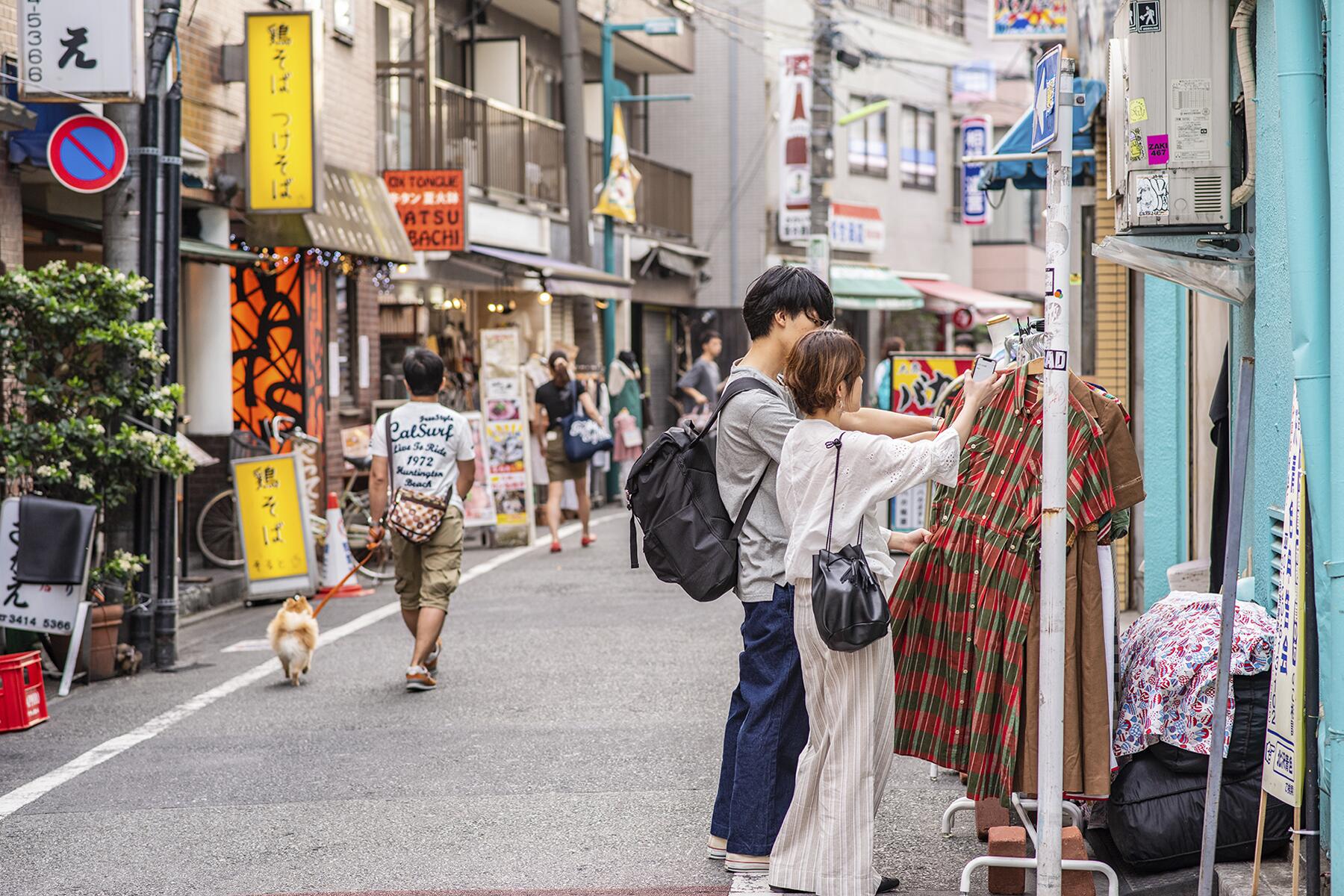How to host or attend clothing swaps while traveling, and why you should.
Who actually knows how much clothing they own?
Back in 2017, on the brink of my first foray abroad as a digital nomad, I conducted a painstaking audit of everything in my wardrobe. It revealed that I had an excessive 293 items of clothing, even though I had already attended three car boot sales, sent kilos of bursting-from-the-seams bags to thrift stores and charity shops, and sold around $2,600 worth of unwanted threads on eBay. Comically, 22% of my wardrobe was made up of swimwear, a collection I amassed over a decade living in London, a city famously lacking in tropical flair.
It was time to admit that owning and buying too many clothes was a silently pressing predicament of mine. Though I had never identified with Isla Fisher’s character in the 2009 film Confessions of a Shopaholic, clearly it was “want” rather than “need” that propelled my constant wardrobe expansion.
Mildly horrified by my habitual clothing consumption behavior, I made three significant, joy-sparking changes. Firstly, I have a self-imposed cap of 10 new clothing items per year. Secondly, I use a digital wardrobe app called Save Your Wardrobe to catalog everything I own right down to the last t-shirt. This way, I can always check on my inventory, and I’m deterred from purchasing doubles or triples of the same thing. Lastly, in an attempt to wean myself from fast fashion which creates 92 million tons of clothing waste annually, according to a 2020 report, I regularly attend and organize clothing swaps wherever I go.
How to Host a Clothing Swap
Since making the world my office in 2017, I have traveled between Bali, Belize, Bonaire, Brazil, and other warm-weather locations. I typically seek out or orchestrate a clothing swap towards the end of my stay in a country when I might have stuffed my large Antler suitcase with bulky souvenirs and gifts for people back home. As a reformed over-packer who has, in the past, squandered too much money on excess baggage fees, relinquishing things at clothing swaps is a wonderful way to lighten my load before jetting off.
Recommended Fodor’s Video

In Panama City, Panama, I’ve held various clothes-swapping brunches in my living room and invited friends who could bring a plus one. If you’d rather not have people in your personal space, check if you can use the communal areas of your building if you live in an apartment, ask a friend if they’re open to hosting, or secure a free or low-cost public area, like a park.
When living in Playa del Carmen, Mexico, I contacted the manager of a rooftop who allowed me to host the event there free of charge with the requirement that each attendee buy one beverage at the venue. To promote the event, I created a digital flyer which I posted in local Facebook and WhatsApp groups and I asked friends to do the same to amplify the message. It wasn’t too difficult to convince people to haul themselves to a breezy rooftop with Caribbean Sea views in the name of free outfits. This ended up being a wonderful day-turned-night filled with camaraderie, cocktails, and cute clothes, and many ladies were happy to have discovered a fabulous new hangout in the city. Note that you might need supplies like racks and hangers, or at least some blankets to lay clothes on, if you choose to go the venue route.
During my events, the only rule for swappers to abide by is to bring a minimum of two clean, well-maintained items, and they can grab as many newfound treasures as their hearts desire. I found two to be an accessible number so that thrifty travelers could still join for the social element even if they didn’t have too many pieces to give away. Whatever remains unclaimed (and there are always a few items), I donate to a local not-for-profit. In Mexico, that was a shelter for single mothers, and in Panama, it was a church group. You can find any organization near you that might benefit from the garments and create whatever guidelines you wish for your sustainable style soiree.
How to Attend a Clothing Swap While Traveling
First things first, round up all the items you’d like to give away, ensure they are in good shape, and launder them. Don’t take “one man’s trash is another man’s treasure” literally and give out tattered, stained, hole-ridden garb.

To find a swap sanctuary near you, type “clothing swap” into the search bar and add your city or town. Also, peek at Meetup.com or Eventbrite and join your local sustainability fashion communities on Facebook. There are digital swaps whereby you send your threads to an individual or a company like Thrift+, Swap Society, Poshmark, or thredUP, and in-person meetups where you’re able to fraternize with fellow second-hand stylistas.
Whenever I return to London, I keep my eyes peeled for regular events and pop-ups like Don’t Swap, Shop, Loanhood, and Verte. The Oxfam charity is also a big advocate for clothes swapping and shwopping—donating clothes in exchange for store credit.
In the U.S., you’ll easily find organized swap events in cities like Orlando, Florida, where there is a big co-ed swap hosted by Oh Eco Orlando in Festival Park, and Portland, Oregon has the Free Clothing Exchange every Sunday of odd months. In New York, check out Grow NYC and the women of color-run Radical Clothes Swap in Los Angeles. Consumption Collab is another California swap association based in the San Gabriel Valley. The circular economy fashion apps and sites like Dopplle, Depop, and Vinted also promote and host exchange events.
From place to place, you’ll find swaps operating on different give-and-take systems. There’s the exchange system (bring one, get one), the no-system system (a free-for-all that focuses on redistributing preloved clothing regardless of how many items someone brings), or the token system. A tad more regimented, with this system swappers are given tokens based on how many unwanted items they are parting with, and more expensive items may be valued higher. I have also attended category-based swaps which focused solely on one attire group per occasion (i.e., workout gear today, dresses next week, and coats thereafter).
The pace at which you may collect clothes might also differ. With first come, first serve swaps, early birds can dig in straight away while other swaps may take the egalitarian approach of waiting for all guests to arrive before the items can be pounced on. Be sure to stick to whichever rules your conscious couture-loving host provides.

If you travel often and regularly have items you’d like to give away, you could also consider creating a one-sided swap ritual of sorts by actively choosing hotels like Belize’s Copal Tree Lodge or Scrub Island Resort in the British Virgin Islands that are part of Pack for a Purpose, an organization that provides supplies for children and families around the world.
Why You Should Host or Attend Clothing Swaps
Sometimes called “swishing,” clothes swap events champion circular fashion, reducing the demand for new clothing production, which the United Nations estimates doubled between 2000 and 2014. The same report highlighted that the average shopper purchases 60% more clothes than they did two decades ago, but keeps them for half as long.
It isn’t exactly breaking news that we’ve collectively bought into excessive buying. Wardrobes are replenished so rapidly to the extent that one in six young people won’t wear an outfit more than once if it’s been seen on social media according to a study by British environmental charity Hubbub.
The cheaper our clothes are, the more disposable we perceive them to be, and clothes are ending up in massive fashion graveyards that are visible from space. If you’ve been reading this article for five minutes, 10,000 clothing items have been sent to landfill sites in that time. Fashion production accounts for 20% of global wastewater, and textiles are responsible for almost 10% of micro-plastics that end up in oceans.

Beautiful clothes don’t have to break the bank or cost the Earth. Therefore, revamping your wardrobe with preloved clothing swap items is both a sustainable and budget-savvy sartorial decision. There is no better bargain than “free”. Since making second-hand my first choice, I’ve snagged some apparel gems—occasionally with price tags still attached—that have become my most cherished looks like one cobalt floral wrap dress I obtained just in time for a trip to the Maldives or the belted shorts I practically lived in this past summer in Spain.
It isn’t just clothing I gain from these events though. Swaps are such a fun, wallet-free way to rummage through other people’s closets and meet new faces in a relaxed setting. I also love the idea of liberating my clothes to partake in another woman’s life story. I feel a wellspring of joy when a friend claims one of my frocks as I believe it connects us while we’re gallivanting around the globe separately, much like the movie The Sisterhood of the Traveling Pants.
Shedding many of my belongings when I became a location-independent nomad helped me realize that I don’t need as much stuff, and how excess baggage prevents swift movement while also creating mental clutter. There are personal and planetary benefits of managing the number of clothes we own and curbing our fast food-like appetites for fast fashion. Clothing swaps can help with that.



